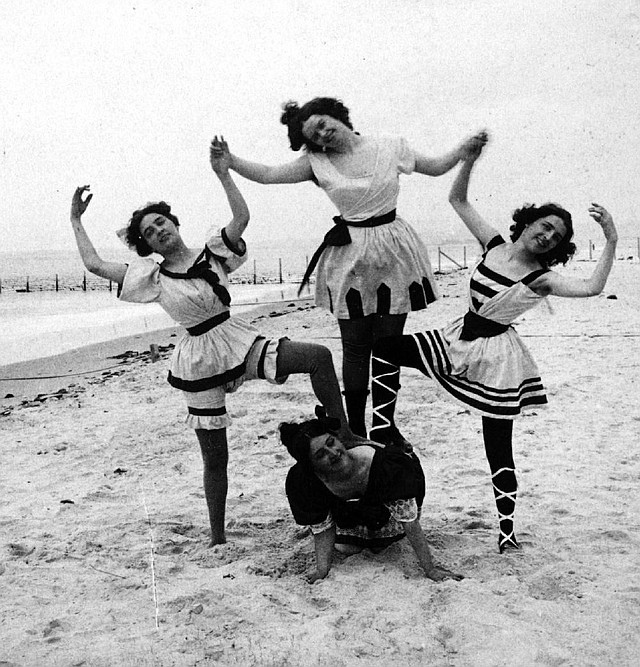Polka-dot bikini? Try canvas dress!
Swimsuit styles have changed a great deal over the years, as this photo, taken at Coney Island, N.Y. around 1898, shows. Illustrates KIDSPOST-SWIMSUITS (category l), by Marylou Tousignant, special to The Washington Post. Moved Monday June 2, 2014. (MUST CREDIT: Strohmeyer & Wyman/Library of Congress)
Monday, June 23, 2014
The thought of trying on swimsuits is enough to make some of us sweat. Be grateful you weren't around 100 or 200 years ago, when swimsuits were made of itchy wool and looked like Hogwarts robes. (Or maybe you'd like to wear a Hogwarts robe to the beach.)
In ancient Greece and Rome, men swam for exercise and to train as warriors. They also went to the public baths. Usually, they wore nothing, but sometimes they would put on loose-fitting gowns called togas.
Women had their own public baths. Some early Roman art shows girls playing sports in what we would call bikinis. But there is no hint that these outfits were used for swimming, which was not something women and girls did.
Over time, bathing and swimming became less popular. In Medieval Europe, people thought that public bathing helped spread diseases that killed millions and wiped out entire towns during the Middle Ages.
It wasn't until the 17th century that swimming and public bathing spas became popular again. Women were able to enjoy these activities, too, although they had to do so in nightgownlike dresses. Showing off one's body was improper, so people covered themselves as much as possible.
A British fashion report from 1687 described ladies' "bathing costumes." The dresses were made of stiff canvas and had big sleeves. The sleeves filled with water and kept the gowns from clinging and revealing too much. Men wore canvas pants called drawers and vests called waistcoats.
Men's one-piece wool swimsuits looked like long underwear, with full-length sleeves and legs. Women's bathing dresses often had high collars and went all the way down to their toes. They also wore bathing caps and long black stockings.
Women were expected to be modest in other
ways as well. Some, like Martha Washington, had lead weights sewn into the hems of their bathing gowns so the clothing would not float up. Others took to the water inside covered wooden frames called "bathing machines."
This term also was used for small wooden cabins at Atlantic Ocean beaches in the early to mid-1800s. The cabins were set on tall wheels. While the bather was inside changing, a horse pulled the machine into the ocean. When the water was high enough, the horse was taken ashore. The bather could then step down from the cabin and into the sea. Few people ashore saw anything but a head bobbing in the surf.
Many beaches had separate swim times for men and women. Colored flags were posted to let them know when it was their turn to be in the water.
Until the 1860s, men and boys in England commonly swam naked in lakes, rivers and seas. But later in the Victorian period, more areas required swimming costumes, and so swimming in one's underwear became popular. Striped shirts and shorts were the rage for men in the 1870s. Flannel replaced wool and linen as the most popular material for bathing suits. It was thought to be warmer when swimming in the cold sea.
Women, meanwhile, were shifting to bloomers -- a long skirt worn over loose pants. The skirt's hem was about three inches above the ankle, which was pretty shockingly high at the time. Gloves, a belt, a cap and rubber shoes completed the outfit.
As swimming grew more popular among European women, they traded their skirts for a less bulky trousers-and-blouse swim garment. American women found that look too manly and kept their skirts decades longer. They also wore toe-length cloaks over their wet suits when crossing the beach.
When they began sharing the beach with men at the turn of the 20th century, American women wanted more stylish swim attire. And they wanted their suits to be more functional.
Sleeves were shortened, then done away with. Necklines were lowered. Colored braid, ribbons and bows were added. A one-piece "princess" suit, with a separate skirt, was a big hit, as were matching mother-daughter suits.
Men's suits were changing, too, but not always for the better. The first modern swim trunks actually made swimming more difficult because they weighed 9 pounds when wet and could slip off.
Form-fitting suits came along in the 1930s. Swimsuits became smaller. Men removed their tops in 1937. Bikinis followed nine years later. With the arrival of new fabrics such as spandex and Lycra, women's and girls' suits were sleeker. Men's and boys' trunks, meanwhile, got baggier.
RACY ATTIRE
Timing is everything in competitive swimming. One one-hundredth of a second can decide who wins a medal. So swimmers are always looking for ways to cut a sliver off their racing times.
In the 1990s, swimsuit makers had a bold new idea: high-tech bodysuits. U.S. space engineers helped with the design and testing of some of these suits. They were made of lighter materials such as plastic and rubber, which soak up less water than woven materials. Some bodysuits had no stitching, which also reduced the water's "drag."
And their skintight fit kept muscles from tiring as quickly.
As a result, swimmers went faster. At the 2008 Summer Olympics, more than 90 percent of all swim medals were won by athletes wearing Speedo's LZR Racer bodysuit. Baltimore's Michael Phelps, who won eight gold medals at those Games, said his LZR suit made him "feel like a rocket" in the pool.
In 2010, the sport's top officials banned the performance-enhancing, full-length suits from major swim events. They put limits on the thickness and type of materials used in suits, as well as their length.
But that hasn't stopped researchers. They are working on new types of goggles and swim caps.
ActiveStyle on 06/23/2014
